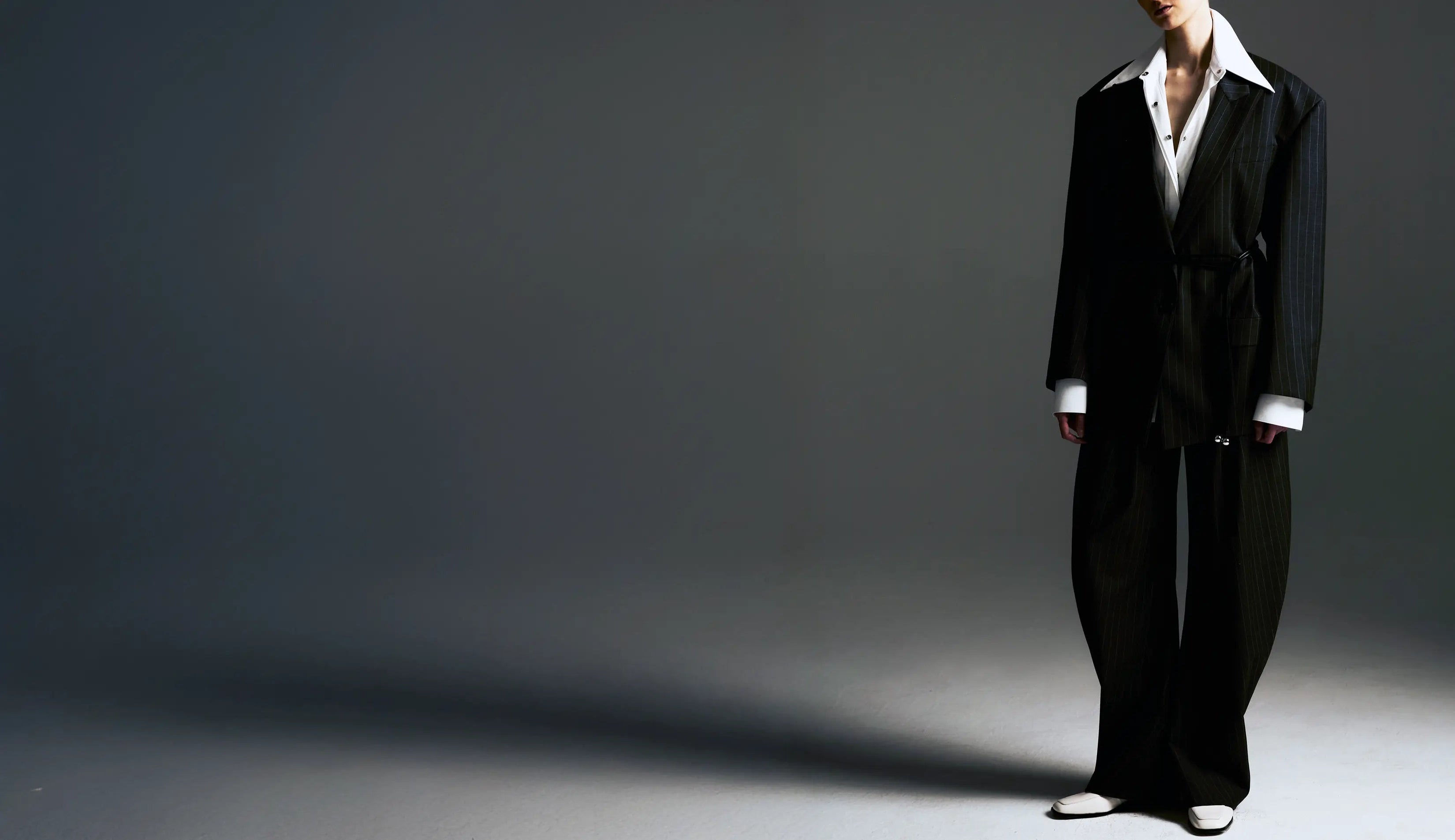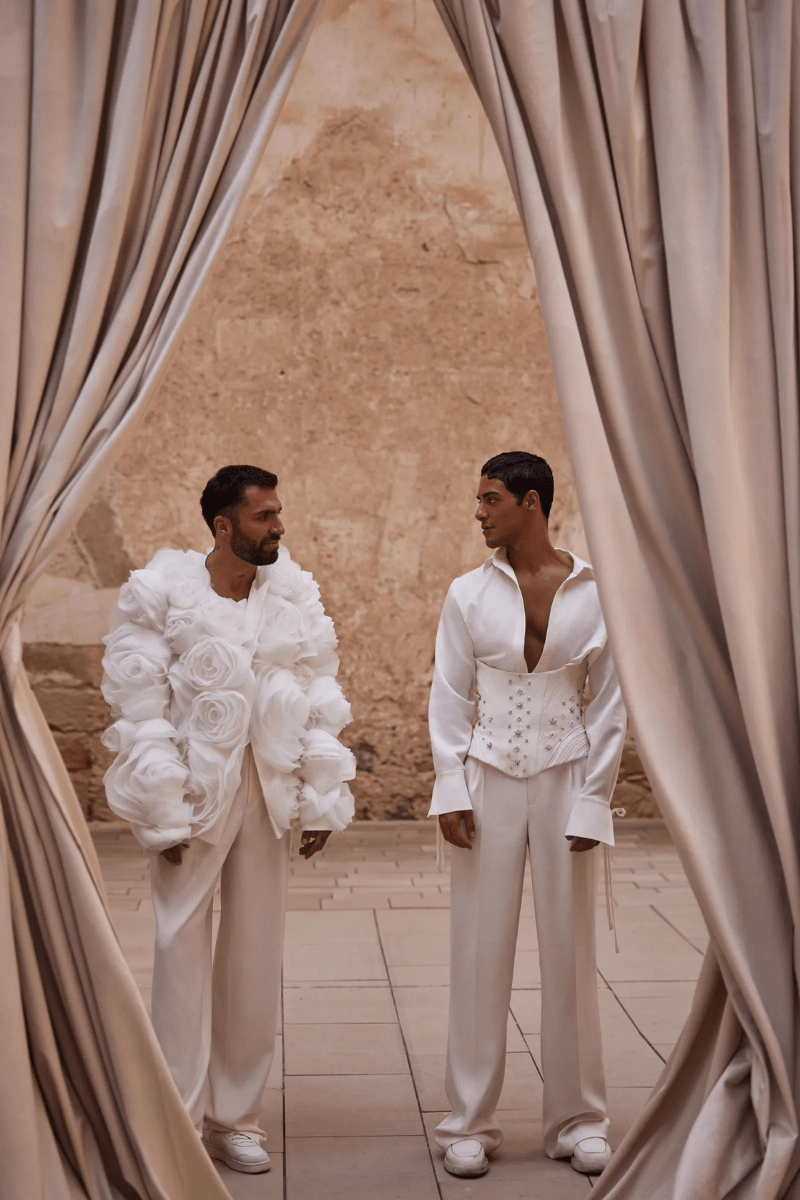Recalibrating Rather Than Rejecting
The relationship between a person and their clothing transcends the merely aesthetic—it operates on two distinct but interconnected levels. When a garment truly works, it addresses the immediate need for physical fit while simultaneously answering deeper questions about identity, presentation, and cultural positioning. Nowhere is this dual function more evident than in the realm of custom suiting.
The Corporate Armor Paradox
The traditional men's suit—that ubiquitous symbol of professionalism that's haunted department store racks since before Talking Heads warned us about the dangers of becoming a "psycho killer" in identical corporate uniforms—has always existed in a strange liminal space. It simultaneously conceals the individual through standardization while, paradoxically, serving as one of the most personal garments someone might own.
The off-the-rack version is to personal style what fast food is to cuisine—nominally satisfying an immediate need while leaving a lingering emptiness. It's the sartorial equivalent of scrolling mindlessly through social media when what you really need is genuine connection.
A custom suit, in contrast, doesn't merely fit better—it creates a dialogue between who you are and how you present yourself to the world. When a jacket is constructed specifically for your shoulder slope, when trousers acknowledge the actual proportions of your body rather than some standardized ideal from a fit model who hasn't eaten carbs since 2007, the result isn't just comfort. It's a physical manifestation of recognition.
In The Fitting Room, Theory Meets Reality
The technical challenge of creating a suit for an actual human body rather than a theoretical average reveals more about our cultural relationship with clothing than countless runway analyses ever could. When a client with broad shoulders and narrow hips tries on a traditionally cut jacket, the abstract concept of "standardized sizing" becomes concretely visible in puckered lapels and collars that gap like a politician's promises.
What emerges in the fitting room isn't just a better-fitting garment but a revelation: most people have spent their entire lives believing that their bodies were the problem when the real issue was always the standardization of clothing designed to fit everyone and therefore fitting no one particularly well.
The moment when a client first experiences a garment built specifically for their proportions has less in common with typical retail therapy and more with the transformative scene in every 90s teen movie where the protagonist finally sees themselves clearly. It's Clueless meets expert craftsmanship—a momentary parting of the clouds of self-doubt to reveal something authentic underneath.
Tailoring Without Templates
The bespoke process doesn't just solve practical problems of fit—it addresses the fundamental limitations of clothing designed around simplified binaries. Traditional menswear and womenswear categories operate like outdated software running on a far more sophisticated operating system, struggling to accommodate the complexity of actual human bodies and identities.
A custom garment doesn't force the wearer into masculine or feminine archetypes. Rather than rejecting conventional proportions outright, it recalibrates them—shifting balance points incrementally, adjusting allowances thoughtfully, creating a garment that inhabits the specific territory where the client's body, identity, and aesthetic sensibilities converge.
This isn't simply "androgynous styling" as understood by fashion magazines—it's a fundamental reimagining of the relationship between clothing and the individual, where the garment becomes a site of negotiation between personal expression and cultural context.
The Technical Rebellion
The technical elements of custom tailoring represent a quiet rebellion against disposable fashion's planned obsolescence. Hand-stitched canvassing, functioning buttonholes, and properly pitched sleeves aren't merely luxury signifiers—they're a commitment to durability in an era where most garments are designed to fall apart just in time for next season's slightly modified version.
When a lapel is hand-padded rather than fused, it doesn't simply look better—it tells a different story about our relationship with time. The garment ages with its wearer, developing a patina of experience rather than simply wearing out. It exists outside the frantic cycle of trend-chasing that leaves both our closets and our landfills perpetually full yet somehow emotionally empty.
The Psychological Tailoring
The psychological impact of a well-fitted custom suit extends beyond the moment of wearing. Like a reset button on a vintage Nintendo (when getting stuck in a game actually required starting over rather than just downloading an update), it recalibrates your understanding of how clothing should interact with your body.
Once you've experienced a jacket that doesn't strain across your back when you reach forward, trousers that don't require constant adjustment throughout the day, the psychological tolerance for uncomfortable clothing permanently diminishes. This isn't mere luxury—it's a fundamental shift in expectations that ripples through every subsequent clothing decision.
The custom suit becomes less a specific garment and more a reference point for how all clothing could feel if it were designed with actual human bodies and experiences in mind.
Sustainability Beyond Marketing
The conversation about sustainability often happens at the abstract level of materials and manufacturing, but the most meaningful analysis examines practical implementation. A custom garment that lasts for years, that can be altered as bodies change, that remains relevant beyond seasonal trends, represents a form of sustainability that transcends marketing narratives about recycled packaging or greenwashed manufacturing processes.
When a suit is constructed with longevity in mind—not just in materials but in style—it steps outside the accelerated consumption cycle that defines contemporary fashion. This isn't sustainability as virtue-signaling but as practical reality: fewer garments, worn more frequently, valued more deeply.
Towards an Unresolved Conclusion
As fashion's pendulum swings between maximalism and minimalism, between sustainability as marketing concept and genuine environmental concern, between inclusion as buzzword and authentic recognition of diversity, the custom suit offers not answers but productive tensions. It acknowledges the complexity of our relationship with clothing—both deeply personal and inevitably cultural, both practical necessity and emotional signifier.
What emerges isn't a neat resolution but an ongoing conversation between craft and identity, between individual expression and cultural context—a negotiation materialized in fabric and thread that reflects our collective ambivalence about conformity, consumption, and authenticity. In this unresolved space, the custom suit becomes not just something you wear but something you inhabit—a second skin tailored not just to your measurements but to your particular place in the world.
Interested in exploring how a custom suit might transform your wardrobe and your relationship with clothing? Contact The Tailory New York to schedule an appointment with our team of expert Designers.




